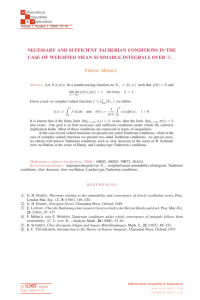p
advertisement
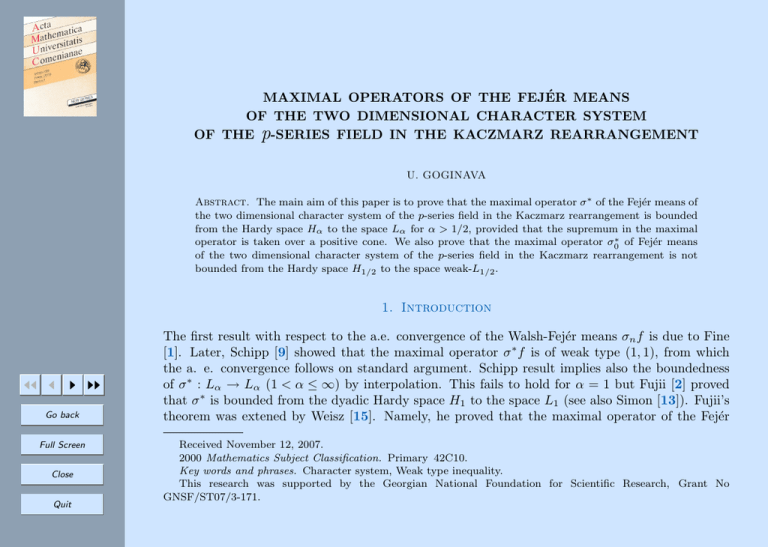
MAXIMAL OPERATORS OF THE FEJÉR MEANS
OF THE TWO DIMENSIONAL CHARACTER SYSTEM
OF THE p-SERIES FIELD IN THE KACZMARZ REARRANGEMENT
U. GOGINAVA
Abstract. The main aim of this paper is to prove that the maximal operator σ ∗ of the Fejér means of
the two dimensional character system of the p-series field in the Kaczmarz rearrangement is bounded
from the Hardy space Hα to the space Lα for α > 1/2, provided that the supremum in the maximal
operator is taken over a positive cone. We also prove that the maximal operator σ0∗ of Fejér means
of the two dimensional character system of the p-series field in the Kaczmarz rearrangement is not
bounded from the Hardy space H1/2 to the space weak-L1/2 .
1. Introduction
JJ J
I II
Go back
Full Screen
Close
Quit
The first result with respect to the a.e. convergence of the Walsh-Fejér means σn f is due to Fine
[1]. Later, Schipp [9] showed that the maximal operator σ ∗ f is of weak type (1, 1), from which
the a. e. convergence follows on standard argument. Schipp result implies also the boundedness
of σ ∗ : Lα → Lα (1 < α ≤ ∞) by interpolation. This fails to hold for α = 1 but Fujii [2] proved
that σ ∗ is bounded from the dyadic Hardy space H1 to the space L1 (see also Simon [13]). Fujii’s
theorem was extened by Weisz [15]. Namely, he proved that the maximal operator of the Fejér
Received November 12, 2007.
2000 Mathematics Subject Classification. Primary 42C10.
Key words and phrases. Character system, Weak type inequality.
This research was supported by the Georgian National Foundation for Scientific Research, Grant No
GNSF/ST07/3-171.
JJ J
I II
Go back
Full Screen
Close
Quit
means of the one-dimensional Walsh-Fourier series is bounded from the martingale Hardy space
Hα to the space Lα for α > 1/2. Simon [11] gave a counterexample, which shows that this
boundedness does not hold for 0 < α < 1/2. In the endpoint case α = 1/2 Weisz [17] proved that
σ ∗ is bounded from the Hardy space H1/2 (G2 ) to the space weak-L1/2 (G2 ). The author [6] proved
that σ ∗ is not bounded from the Hardy space H1/2 (G2 ) to the space L1/2 (G2 ).
If the Walsh system is taken in the Kaczmarz ordening, the analogous to the statement of Schipp
[9] is due to Gát [3]. Moreover he proved an (H1 , L1 )-type estimation. Gát result was extended to
[17]
the Hardy space by Simon [12], who proved that σ ∗ is of type (Hα , Lα ) for α > 1/2. Weisz
showed that in endpoint case α = 1/2 the maximal operator is of weak type H1/2 , L1/2 .
Gát and Nagy [4] proved the a. e. convergence σn f → f (n → ∞) for an integrable function
f ∈ L1 (Gp ), where σn f is the Fejér means of the function f with respect to the character system
in the Kaczmarz rearrangement. This result was generalized by the author [7] and it is proved
that the maximal operator σ ∗ of the Fejér means of the one dimensional character system of the pseries field in the Kaczmarz rearrangement is bounded from the Hardy space H1/2 (Gp ) to the space
weak-L1/2 (Gp ). By interpolation it follows that σ ∗ is of type (Hα , Lα ) for α > 1/2. We also prove
that the assumption α > 1/2 is essentiall, in particular, it is proved that the maximal operator σ ∗
is not bounded from the Hardy space H1/2 (Gp ) to the space L1/2 (Gp ). By interpolation it follows
that σ ∗ is not of type (Hα , weak-Lα ) for 0 < α < 1/2.
The aim of this paper is to prove that the maximal operator of Fejér means of the two dimensional
character system of the p-series field in the Kaczmarz rearrangement is bounded from the Hardy
space Hα (Gp × Gp ) to the space Lα (Gp × Gp ) for α > 1/2 and is of weak type (1, 1) provided that
the supremum in the maximal operator is taken over a positive cone. So we obtain that the Fejer
means of a function f ∈ L1 (Gp × Gp ) converge a. e. to the function in the question, provided again
that the limit is taken over a positive cone. We also proved that the maximal operator σ0∗ of Fejér
means of the two dimensional character system of the p-series field in the Kaczmarz rearrangement
is not bounded from the Hardy space H1/2 (Gp ×Gp ) to the space weak-L1/2 (Gp ×Gp ). Thus, in the
question of boundedness of the maximal operator σ0∗ the case of two dimensional character system
of the p-series field in the Kaczmarz rearrangement differs from that one-dimensional character
system of the p-series field in the Kaczmarz rearrangement. By Theorem 2 and interpolation it
follows that σ0∗ is not bounded from Hα (Gp × Gp ) to the space weak-Lα (Gp × Gp ) for 0 < α ≤ 1/2.
In particular, from Theorem 2 we have that in Theorem 1 the assumption α > 1/2 is essential.
2. Definitions and Notation
Let P denote the set of positive integers, N := P ∪ {0}. Let 2 ≤ p ∈ N and denote by Zp the pth
cyclic group, that is, Zp can be represented by the set {0, 1, . . . , p − 1}, where the group operation
is the mod p addition and every subset is open. The Haar measure on Zp is given in the way that
µk ({j}) :=
1
j
(j ∈ Z) .
The group operation on Gp is the coordinate-wise addition, the normalized Haar measure µ is the
product measure. The topology on Gp is the product topology, a base for the neighborhoods of
Gp can be given in the following way:
JJ J
I II
Go back
I0 (x) := Gp ,
In (x) := {y ∈ Gp : y = (x0 , . . . , xn−1 , yn , yn+1 , . . .)} ,
(x ∈ Gp , n ∈ N) .
Let 0 = (0 : i ∈ N) ∈ Gp denote the null element of Gp , In := In (0) (n ∈ N), I n := Gp \ In . Let
Full Screen
∆ := {In (x) : x ∈ Gp , n ∈ N} .
Close
Quit
The elements of ∆ are intervals of Gp . Set ei := (0, . . . , 0, 1, 0, . . .) ∈ Gp whose i-th coordinate is
1, the rest are zeros.
The norm (or quasinorm) of the space Lα (Gp × Gp ) is defined by
1/α
Z
f x1 , x2 α dµ x1 , x2
,
(0 < α < +∞) .
kf kα :=
Gp ×Gp
Let Γ (p) denote the character group of Gp . We arrange the elements of Γ (p) as follows. For
k ∈ N and x ∈ Gp denote by rk the k-th generalized Rademacher function
√
2π i xk
rk (x) := exp
i := −1, x ∈ Gp , k ∈ N .
p
Let n ∈ N. Then
n=
∞
X
n i pi ,
where 0 ≤ ni < p (ni , i ∈ N) ,
i=0
n is expressed in the number system with base p. Denote by
JJ J
I II
Go back
Full Screen
|n| := max(j ∈ N :nj 6= 0)
i. e., p|n| ≤ n < p|n|+1 .
Now, we define the sequence of functions ψ := (ψn : n ∈ N) by
ψn (x) :=
∞
Y
nk
(rk (x))
( x ∈ Gp , n ∈ N) .
k=0
Close
Quit
We remark that Γ (p) = {ψn : n ∈ N} is a complete orthogonal system with respect to the normalized Haar measure on Gp .
The character group Γ (p) can be given in the Kaczmarz rearrangement as follows: Γ (p) =
{χn : n ∈ N} , where
|n|−1
χn (x) :=
n
r|n||n| (x)
Y
(r|n|−1−k (x))nk
( x ∈ Gp , n ∈ P) ,
k=0
( x ∈ Gp ) .
χ0 (x) = 1
Let the transformation τA : Gp → Gp be defined as follows:
τA (x) := (xA−1 , xA−2 , . . . , x0 , xA , xA+1 , . . .).
The transformation is measure-preservingand and τA (τA (x)) = x. By the definition of τA , we
have
n
χn (x) = r|n||n| (x)ψn−n|n| pn (τ|n| (x))
(n ∈ N, x ∈ Gp ).
The rectangular partial sums of the double Fourier series are defined as follows:
SM,N (f ; x1 , x2 ) :=
JJ J
I II
M
−1 N
−1
X
X
fb(i, j) χi x1 χj x2 ,
i=0 j=0
where the number
Go back
Z
fb(i, j) =
Full Screen
Close
Quit
f x1 , x2 χi x1 χj x2 dµ x1 , x2
Gp ×Gp
is said to be the (i, j)-th Fourier coefficient of the function f . Let
In,n x1 , x2 := In x1 × In x2 .
The σ-algebra generated by the dyadic rectangles
In,n x1 , x2 : x1 , x2 ∈ Gp × Gp
will be denoted by Fn,n (n ∈ N).
Denote by f = f (n,n) , n ∈ N martingale with respect to (Fn,n , n ∈ N) (for details see, e. g.
[14, 16]
The diagonal maximal function of a martingale f is defined by
f ∗ = sup f (n,n) .
n∈N
In case f ∈ L1 (Gp × Gp ), diagonal maximal function can also be given by
Z
1
1
2
1
2 ∗
1
2
f u , u dµ u , u ,
f x , x = sup
1
2
n∈N µ (In,n (x , x )) In,n (x1 ,x2 )
1
2
x , x ∈ Gp × Gp .
For 0 < p < ∞ the Hardy martingale space Hp (Gp × Gp ) consists of all martingales for which
JJ J
I II
Go back
Full Screen
Close
Quit
kf kHp := kf ∗ kp < ∞.
If f ∈ L1 (Gp × Gp ) then it is easy to show that the sequence (Spn ,pn (f ) : n ∈ N) is a martingale.
If f is a martingale, that is f = (f (n,n) : n ∈ N), then the Fourier coefficients must be defined in
a little bit different way:
Z
fb(i, j) = lim
f (k,k) x1 , x2 χi x1 χj x2 dµ x1 , x2 .
k→∞
G×G
The Fourier coefficients of f ∈ L1 (Gp × Gp ) are the same as the ones of the martingale
(Spn ,pn (f ) : n ∈ N) obtained from f .
For n, m ∈ P and a martingale f the Fejér means of order (n, m) of the two-dimensional
character system of the p-series field in the Kaczmarz rearrangement of the martingale f is given
by
n−1 m−1
1 XX
Si,j (f ; x1 , x2 ).
σn,m (f ; x , x ) =
nm i=0 j=0
1
2
For the martingale f , the restricted maximal operator of the Fejér means is defined by
σλ∗ f x1 , x2 =
sup
|σn,m (f ; x1 , x2 )|,
λ > 0.
p−λ ≤n/m≤pλ
The Dirichlet kernels and Fejér kernels are defined as follows
Dnγ (x) :=
JJ J
I II
Go back
Full Screen
Close
Quit
n−1
X
γj (x) ,
Knγ (x) :=
j=0
where γ is either ψ or χ.
The pn th Dirichlet kernels have a closed form:
(
pn if x ∈ In ,
ψ
χ
Dpn (x) = Dpn (x) =
(1)
0
if x ∈
/ In ,
n−1
X
Djγ (x) ,
j=0
where x ∈ Gp .
3. Formulation of Main Results
Theorem 1. Let α > 1/2. Then the maximal operator σλ∗ is bounded from the Hardy space
Hα (Gp × Gp ) to the space Lα (Gp × Gp ). Especialy, if f ∈ L1 (Gp × Gp ) then
µ (σλ∗ > y) ≤
c
kf k1 .
y
Corollary 1. If f ∈ L1 (Gp × Gp ), then
σn,m f x1 , x2 → f x1 , x2
a. e.
as min (n, m) → ∞ and p−λ ≤ n/m ≤ pλ (λ > 0) .
JJ J
I II
Theorem 2. The maximal operator σ0∗ is not bounded from the Hardy space H1/2 (Gp × Gp ) to
the space weak-L1/2 (Gp × Gp ).
Go back
Full Screen
Close
Quit
4. Auxiliary Propositions
We shall need the following lemmas
Lemma 1 (Gát, Nagy [4]). Let A ∈ N and n := nA pA + nA−1 pA−1 + · · · + n0 p0 . Then
nKnχ (x) = 1 +
p−1
A−1
XX
rji (x) pj Kpψj (τj (x)) +
j=0 i=1
+ pA
nX
A −1
A−1
X
pj Dpψj (x)
j=0
p−1 X
l−1
X
rji (x)
l=1 i=0
ψ
nA
l
rA
(x) KpψA (τA (x)) + rA
(x) n − nA pA Kn−n
A (τA (x))
Ap
l=1
+ n − nA p
A
A −1
nX
i
rA
(x) DpψA
(x) + +p
i=0
A
j−1
nX
A −1 X
i
rA
(x) DpψA (x) .
j=1 i=0
Lemma 2 (Gát, Nagy [4]). Let A, l ∈ N, A > l and x ∈ Il \ Il+1 . Then
if x − xl el ∈
/ IA ,
0,
ψ
l
KpA (x) =
p
if x − xl el ∈ IA .
1 − rl (x)
JJ J
I II
Go back
Lemma 3 ([7]). Let n < pA+1 , A > N and x ∈
0, . . . , 0, xl 6= 0, 0, . . . , 0) m = −1, 0, . . . , l − 1, l = 0, . . . , N . Then
Z
cpA
n Knψ (τA (x − t)) dµ (t) ≤ m+l ,
p
IN (x0 , . . . , xm−1 , xm 6= 0 ,
IN
Full Screen
where
Close
Quit
IN (x0 , . . . , xm−1 , xm 6= 0, 0, . . . , 0, xl 6= 0, 0, . . . , 0)
:= IN (0, . . . , 0, xl 6= 0, 0, . . . , 0)
for m = −1,
and
IN (x0 , . . . , xm−1 , xm 6= 0, 0, . . . , 0, xl 6= 0, 0, . . . , 0)
:= IN (x0 , . . . , xm−1 , xm 6= 0, 0, . . . , 0) ,
for l = N.
Lemma 4 ([5]). Let A ∈ N and nA := p2A + p2A−2 + . . . + p2 + p0 . Then
nA−1 |KnA−1 (x)| ≥ cp2k+2s
for x ∈ I2A (0, . . . , 0, x2k 6= 0, 0, . . . , 0, x2s 6= 0, x2s+1 , . . . , x2A−1 ), k = 0, 1, . . . , A−3, s = k + 2,
k + 3, . . . , A − 1.
Lemma 5. Let x ∈ I N and n ≥ pN . Then
Z
JJ J
I II
Go back
Full Screen
Close
Quit
|Knχ (x − t)|dµ (t)
IN
≤c
( N l−1
X X
l=0 m=−1
+
1
pm+l
1IN (x0 ,...,xm−1 ,xm 6=0,0,...,0,xl 6=0,0,...,0) (x)
j−1
X
1
p2j
1IN (0,...,0,xl 6=0,0,...,0,,xj ,...,xN −1 ) (x) .
l
p
j=1
N
1 X
p2N
l=0
Proof. From Lemma 1 we write
A
X
n |Knχ (x)| ≤ c 1 +
pj Kpψj (τj (x))
j=0
(2)
A
X
ψ
+
pj Dpψj (x) + n − nA pA Kn−n
.
A (τA (x))
Ap
j=0
Using Lemma 3 we obtain
Z
ψ
1
n − nA pA Kn−n
A (τA (x − t)) dµ (t)
p
A
n
IN
(3)
≤c
( N l−1
X X
l=0 m=−1
1
pm+l
)
1IN (x0 ,...,xm−1 ,xm 6=0,0,...,0,xl 6=0,0,...,0) (x) .
Let x ∈ IN (x0 , . . . , xm−1 , xm 6= 0, 0, . . . , 0, xl 6= 0, 0, . . . , 0) for some m = −1, . . . , l − 1,
l = 0, . . . , N . Then using Lemma 2 Kpψj (τj (x − t)) 6= 0 (j > N ) implies
JJ J
I II
Go back
Full Screen
Close
Quit
t ∈ Ij (0, . . . , 0, xN , . . . , xj−1 ) ,
m = −1.
Consequently, we can write
Z
cpj
pj Kpψj (τj (x − t)) dµ (t) ≤ j pj−l 1IN (0,...,0,xl 6=0,0,...,0) (x)
p
IN
(4)
cpj
= l 1IN (0,...,0,xl 6=0,0,...,0) (x) .
p
Let j < N . Then using Lemma 2 Kpψj (τj (x − t)) 6= 0 implies
x ∈ IN (0, . . . , 0, xl 6= 0, 0, . . . , 0, xj , . . . , xN −1 ) , l = −1, 0, . . . , j − 1.
Hence we have
Z
j−1
cpj X j−l
pj Kpψj (τj (x − t)) dµ (t) ≤ N
p 1IN (0,...,0,xl 6=0,0,...,0,xj ,...,xN −1 ) (x)
p
l=0
IN
(5)
=
j−1
cp2j X −l
p 1IN (0,...,0,xl 6=0,0,...,0,xj ,...,xN −1 ) (x) .
pN
l=0
From (1) we can write
Z N −1
c X j ψ
ψ
p
p Dpj (x)
Dpj (x − t) dµ (t) ≤ N
p
j=0
j=0
A
X
JJ J
I II
Go back
(6)
j
IN
N −1
c X 2j
p 1IN (0,...,0,xj ,...,xN −1 ) (x) .
≤ N
p j=0
Full Screen
Close
Quit
Combining (2)–(6) we complete the proof of Lemma 5.
5. Proofs of Main results
Proof of Theorem 1. In order to prove Theorem 1 it is enough to show that (see Simon [11],
Theorem 1)
α
Z
Z
sup
|Knχ (x − t)| dµ (t) dµ (x) ≤ cα p−N ,
for 1/2 < α ≤ 1.
n≥2N
IN
IN
Applying the inequality
∞
X
!α
≤
ak
k=0
∞
X
aα
k
(ak ≥ 0, 0 < α ≤ 1) ,
k=0
from Lemma 5 we can write
α
Z
Z
sup
|Knχ (x − t)| dµ (t) dµ (t)
n≥2N
JJ J
I II
Go back
IN
≤ cα
Full Screen
+
Close
Quit
IN
N
l−1
X
X
l=0 m=−1
1
p2αN
N
X
j=1
Z
1
1IN (x0 ,...,xm−1 ,xm 6=0,0,...,0,xl 6=0,0,...,0) (x) dµ (x)
pα(m+l)
p2jα
G
j−1
X
l=0
1
plα
Z
G
1IN (0,...,0,xl 6=0,0,...,0,,xj ,...,xN −1 ) (x) dµ (x)
j−1 N −j
N
l−1
N
1 X
m
X
X
X
p
p
1
p2jα
≤ cp−N .
≤ cα
+ N 2αN
lα
α(m+l)
pN
p
p
p
p
m=−1
j=1
l=0
l=0
The proof of Theorem 1 is complete.
Proof of Theorem 2. Let A ∈ P and
fA x1 , x2 := Dp2A+1 x1 − Dp2A x1
Dp2A+1 x2 − Dp2A+1 x2 .
It is simple to calculate
(
fbAψ (i, k) =
1, if i, k = p2A , . . . , p2A+1 − 1,
0, otherwise.
and
JJ J
I II
(7)
Go back
Full Screen
ψ
Si,j
ψ 2 ψ
2
1
1
2A
2A
−
D
x
,
D
x
−
D
x
D
x
p
p
j
i
2A
2A+1
if i, j = p + 1, . . . , p
− 1,
1
2
fA x , x ,
fA ; x1 , x2 =
if i, j ≥ p2A+1 ,
0,
otherwise.
Since
Close
fA∗ x1 , x2 = sup Spn ,pn fA ; x1 , x2 = fA x1 , x2 ,
Quit
n∈N
from (1) we get
2
kfA kHα = kfA∗ kα = Dp2A α = p4A(1−1/α) .
(8)
Since
χ
χ
Dk+p
2A (x) − Dp2A (x) = r2A (x) Dk (τ2A (x)) ,
k = 1, 2, . . . , p2A ,
from (7) we obtain
JJ J
I II
Go back
Full Screen
Close
Quit
(9)
σ0χ∗ fA x1 , x2 = sup σn,n fA x1 , x2 ≥ σnA ,nA fA x1 , x2 n∈N
nX
A −1
A −1 nX
1 χ
1
2 =
S
f
x
,
x
i,j A
2
(nA ) i=0 j=0
nX
nX
A −1
A −1
1 χ 1
χ 2
1
2 2A
2A
=
D
(x
)
−
D
x
D
(x
)
−
D
(x
)
p
p
i
j
2
(nA ) 2A
i=p +1 j=p2A +1
nA−1
−1 nA−1 −1 X
X
1 χ
χ
1
1
2
2 2A
2A
D
(x
)
−
D
D
(x
)
−
D
(x
)
(x
)
=
2A
2A
p
p
i+p
j+p
2
(nA ) i=1
j=1
n
X−1 nA−1
X−1 ψ
A−1
ψ
1 1
2
1
2 =
x
r
x
D
τ
x
D
τ
x
r
2A
2A
2A
2A
i
j
(nA )2 i=1
j=1
2
n
ψ
= A−1
KnA−1 τ2A x1 KnψA−1 τ2A x2 .
2
nA
Denote
m,s
(x) := I2A (x0 , x1 , . . . , x2A−2s−2 , x2A−2s−1 = 1, 0, . . . , x2A−2m−1 = 1, 0, . . . , 0)
J2A
and let
k1 ,k1 +1
k2 ,k2 +1
x1 , x2 ∈ J2Al l
x1 × J2Al l
x2 ,
where
kl1
1
A
+
logp A − l,
:=
2
8
kl2
A
1
:=
+
logp A + l
2
8
1
l = 0, 1, . . . ,
logp A .
8
Then from Lemma 4 and (9) we obtain
1
σ0∗ fA
1
2
x ,x
2
p4kl +4kl
p2A+logp
≥c
≥
p4A
√
A−4l 2A+logp
p
√
A+4l
≥ cA.
p4A
On the other hand,
µ x1 , x2 ∈ Gp × Gp : σ0χ∗ fA x1 , x2 ≥ cA
[ 81 logq
≥c
JJ J
I II
[ 18 logq
Full Screen
[ 18
=c
p−1
X
···
x10 =0 x1
2A−2k1 −2
l
√
A]
X
≥c
Quit
A] p−1
X
l=1
Go back
Close
√
X
l=1
√
logq A]
···
pA+logp
1 1
k ,k +1
k2 ,k2 +1
µ J2Al l
x1 × J2Al l
x2
2A−2k1 −2
l
1
2
√
4
p−1
X
=0 x20 =0 x2
p2A−2kl p2A−2kl
=c
p4A
X
l=1
p−1
X
[ 18 logq
1
A−2l A+logp
p
√
X
l=1
√
4
A+2l
=0
A]
1
1
2
p2kl p2kl
logp A
≥c
p
2A+logp
√
A
logp A
= c√
.
Ap2A
Then from (8) we obtain
cA µ
≥
2
x1 , x2 ∈ Gp × Gp : σ0χ∗ fA x1 , x2 ≥ cA
kfA kH1/2
cA log2p A
≥ c log2p A → ∞
p−4A p4A A
as
A → ∞.
Theorem 2 is proved.
We remark that in the case p = 2 Theorem 2 is due to Goginava and Nagy [8].
JJ J
I II
Go back
Full Screen
Close
Quit
1. Fine J., Cesàro summability of Walsh-Fourier series. Proc. Nat. Acad. Sci. USA 41 (1955), 558–591.
2. Fujii N. J., Cesàro summability of Walsh-Fourier series. Proc. Amer. Math. Soc. 77 (1979), 111–116.
3. Gát G., On (C, 1) summability of integrable function with respect to the Walsh-Kaczmarz system, Studia Math.
130 (1998), 135–148.
4. Gát G. and Nagy K., Cesàro summability of the character system of the p-series field in the Kaczmarz rearrangement. Analysis. Math. 28 (2002), 1–23.
5. Blahota I., Gát G. and Goginava U., Maximal operators of Fejér means of double Vilenkin- -Fourier series,
Colloq. Math. 107(2) (2007), 287–296.
6. Goginava U., The maximal operator of the Marcinkiewicz-Fejér means of the d-dimensional Walsh-Fourier
series, East J. Approx. 12(3) (2006), 295–302.
7.
, The maximal operator of the Fejer means of the character system of the p-series field in the Kaczmarz
rearrangement, Publ. Math. Debrecen, 71(1–2) (2007), 43–55.
8. Goginava U. and Nagy K., On the Fejér means of double Fourier series with respect to the Walsh-Kaczmarz
system, Math. Period. Hungarica. 55(1) (2007), 39–45.
9. Schipp F., Certain rearrangements of series in the Walsh series, Mat. Zametki 18 (1975), 193–201.
10. Schipp F., Wade W. R., Simon P. and Pál J., Walsh Series, an Introduction to Dyadic Harmonic Analysis.
Adam Hilger, Bristol, New York, 1990.
11. Simon P., Cesaro summability with respect to two-parameter Walsh system, Monatsh. Math. 131 (2000),
321–334.
12.
, On the Cesàro summability with respect to the Walsh-Kaczmarz system, J. Approx. Theory, 106
(2000), 249–261.
13.
, Investigation with respect to the Vilenkin system, Ann. Univ. Sci. Sect. Math. (Budapest) 27 (1985),
87–101.
14. Weisz F., Martingale Hardy spaces and their applications in Fourier analysis, Springer, Berlin – Heidelberg –
New York, 1994.
15.
, Cesaro summability of one and two-dimensional Walsh-Fourier series. Anal. Math. 22 (1996), 229–
242.
16.
, Summability of multi-dimensional Fourier series and Hardy space, Kluwer Academic, Dordrecht,
2002.
17.
, ϑ-summability of Fourier series, Acta Math. Hungar. 103(1–2) (2004), 139–176.
U. Goginava, Institute of Mathematics, Faculty of Exact and Natural Sciences, Tbilisi State University, Chavchavadze str. 1, Tbilisi 0128, Georgia,
e-mail: u.goginava@math.sci.tsu.ge
JJ J
I II
Go back
Full Screen
Close
Quit
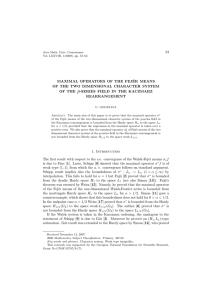
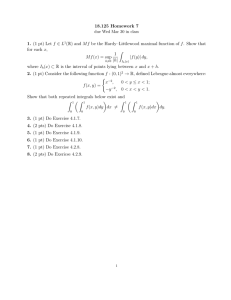

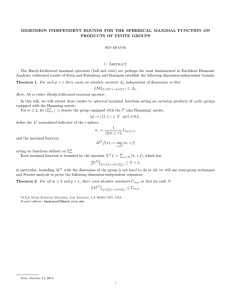

![Mathematics 321 2008–09 Exercises 5 [Due Friday January 30th.]](http://s2.studylib.net/store/data/010730637_1-605d82659e8138195d07d944efcb6d99-300x300.png)
